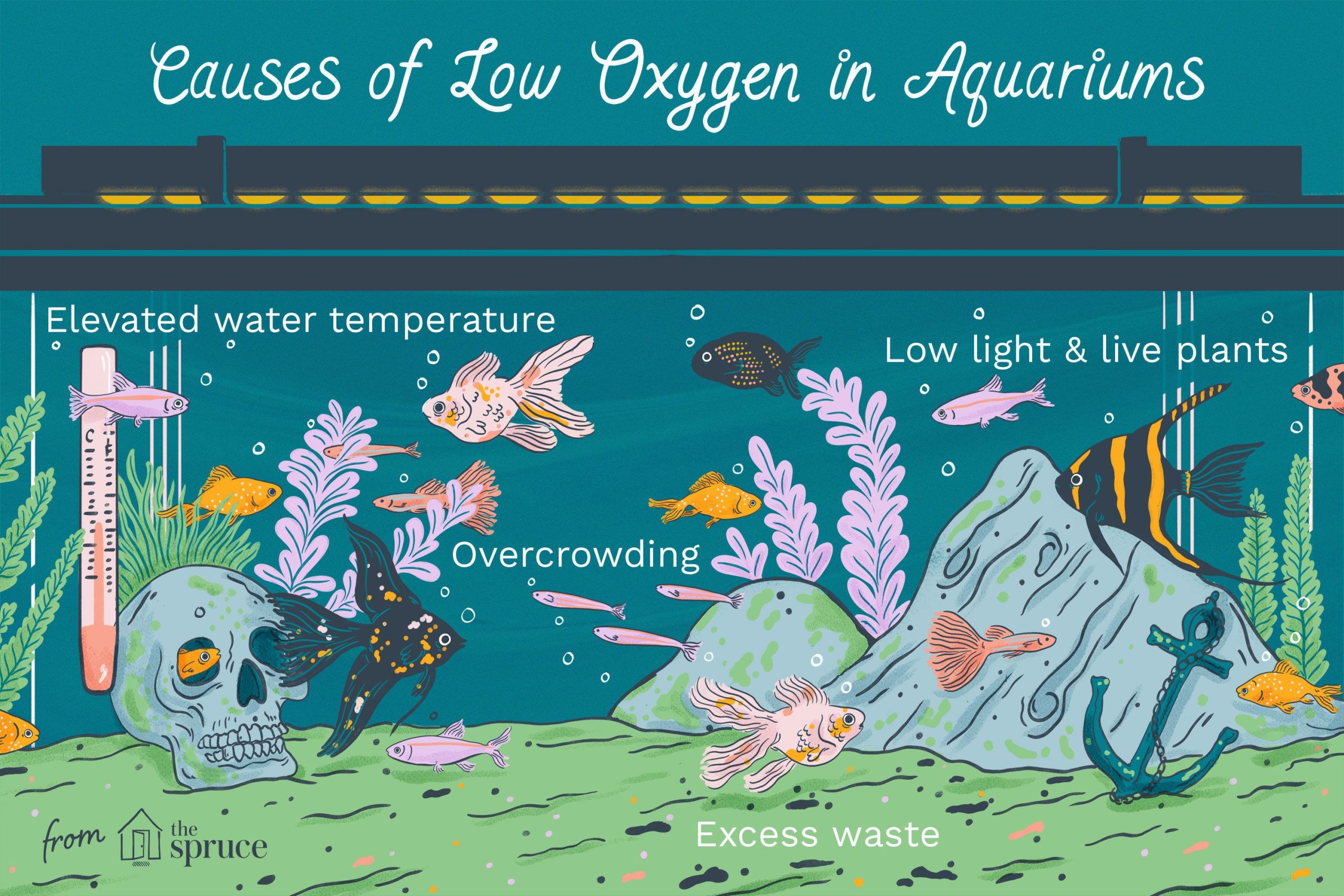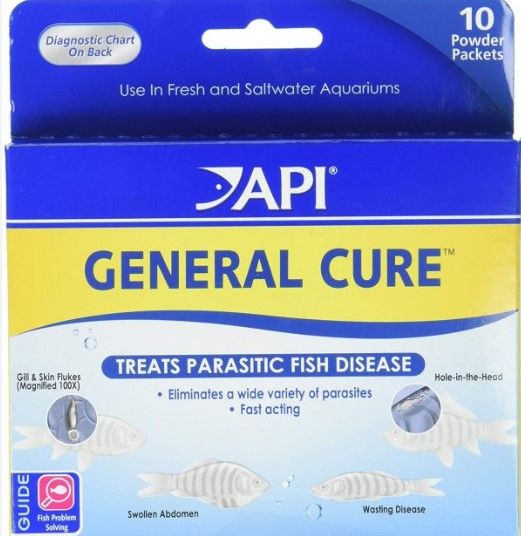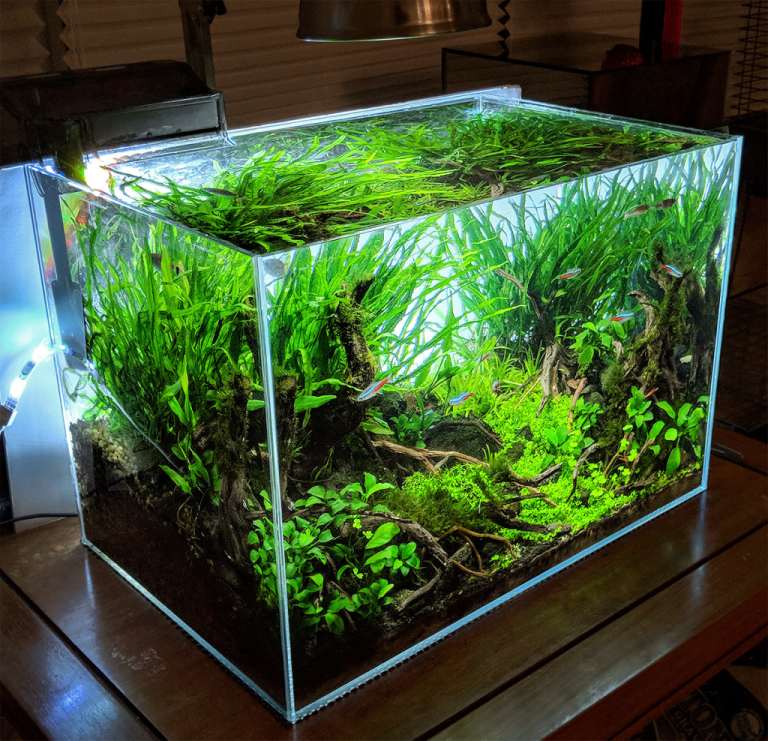Revive Your Fish Tank: Tips to Boost Oxygen Levels!
Increasing oxygen in a fish tank can be done by adding an air stone or increasing surface agitation. A well-maintained fish tank requires an adequate amount of oxygen for the health and well-being of its inhabitants.
Low oxygen levels could lead to stress, illness, and death among fish. Poor water quality and overstocking of fish can decrease oxygen levels and increase the carbon dioxide content in the water. Installing an air stone or increasing surface agitation can help increase oxygen levels in the fish tank.
It is essential to monitor the oxygen levels regularly and maintain proper tank conditions to ensure a healthy environment for your fish. In this article, we will discuss the different ways to increase oxygen in your fish tank and how you can ensure that the oxygen levels stay optimal for the fish’s health.

Credit: adoptandshop.org
Revive Your Fish Tank: Tips To Boost Oxygen Levels!
When it comes to taking care of fish tanks, it is crucial to maintain proper oxygen levels. Oxygen is essential for your fish’s survival, and if the oxygen level in the tank drops down, your fish may experience health issues.
In this blog post, we will be discussing some important tips to revive your fish tank and boost oxygen levels.
Importance Of Oxygen Levels In A Fish Tank
The oxygen level in a fish tank is critical for the survival of your fish. It is because they breathe in oxygen, and when it is not enough, they may suffocate, leading to health problems or even death. Maintaining an adequate oxygen level in your fish tank has several benefits, including:
- Helping fish breathe properly and stay healthy.
- Keeping the water clear and reducing unpleasant odors.
- Enhancing the fish tank’s aesthetic appeal by promoting plant growth.
- Decreasing the accumulation of harmful toxic products in the water, such as ammonia.
Tips To Boost Oxygen Levels
There are several ways to increase oxygen levels in your fish tank. Here are some tips to help you do just that:
- Installing an air pump: An air pump is a small device that uses an electric motor to push oxygen into the water. It creates bubbles in the tank, which helps to increase oxygen levels and enhance the water’s circulation.
- Adding live plants: Plants produce oxygen through photosynthesis, which can significantly increase the oxygen levels in your fish tank. Some of the best plants you can add to your fish tank include anacharis, hornwort, and java moss.
- Cleaning the filter: A dirty filter is less effective and may hinder proper water circulation, causing low oxygen levels. Regularly clean the filter and replace it if necessary to ensure effective filtration and proper oxygen flow.
- Reducing the temperature: Warmer water holds less oxygen than colder water. Try lowering your fish tank’s temperature to increase oxygen levels, but be sure not to make it too cold as it may cause your fish to become ill.
- Reducing fish population: Overcrowding your fish tank may cause the oxygen levels to decrease too quickly. Consider reducing the number of fish in your tank to reduce waste and improve oxygen levels.
- Providing surface agitation: When the surface of the water is agitated, it causes more oxygen to dissolve in the water. Achieve surface agitation by using a bubbler or a filter output that causes ripples on the water’s surface.
Maintaining proper oxygen levels in your fish tank is crucial for the healthy survival of your fish. Use these tips to increase the oxygen levels and improve the quality of life for your fish.
The Problem With Low Oxygen Levels In A Fish Tank
Fishkeeping is a joy for many, but it requires a delicate balance of maintaining water quality. One important aspect of fishkeeping is ensuring adequate oxygen levels in the fish tank. Low oxygen levels might cause various issues and in this section, we will discuss the most common problems resulting from poor oxygenation.
Consistent Fish Health Issues
Fish require oxygen to live, just like any other living creature. When the oxygen levels are low in a fish tank, fish don’t get enough oxygen for their metabolism, resulting in consistent health issues. Here are the key points to consider:
- Poor oxygenation can lead to a weaker immune system in fish, making them more vulnerable to diseases.
- Fish may lose their appetite or exhibit unusual swimming behaviors if they’re not getting sufficient oxygen.
- In severe cases, low oxygen levels can lead to fish dying in the tank.
Decreased Oxygen Levels In The Water
Several reasons can lead to low oxygen levels in the water. Here are some key points to take into account:
- Uneven distribution of fish may result in dead zones, where oxygen is not getting to all parts of the tank.
- Overstocking, overcrowding, or overfeeding may cause oxygen levels to decrease.
- Inadequate equipment, such as a weak filter, is another factor for decreased oxygen levels, as it can’t maintain healthy bacteria populations.
Unattractive Algae Growth
Low oxygen levels in a fish tank may lead to the buildup of unsightly and unwanted algae growth. Here are the key points to consider:
- Increased organic waste from uneaten fish food and fish excretion can cause a buildup of algae.
- Lack of maintenance on the tank’s equipment, such as the filter, may lead to unwanted algae growth.
- Unsightly algae not only looks bad but can also cause harm to fish that need light to stay healthy.
Remembering to maintain oxygenation in your fish tank requires effort, but the benefits to fish health and overall satisfaction outweigh the challenges. Keep fish healthy and happy by regularly checking water quality to avoid low oxygen levels and other preventable issues.
Key Elements That Affect Oxygen Levels In A Fish Tank
Maintaining proper oxygen levels in a fish tank is crucial for the well-being of your fish. Several factors influence the oxygen levels in your fish tank, including the size of the tank, the number of fish, temperature, and water agitation.
Here are some key elements you need to pay attention to determine if your tank has appropriate oxygen levels:
Size Of The Tank
The size of the fish tank plays a critical role in determining the oxygen level. You must have a tank of an appropriate size according to the number of fish you plan to keep. A larger tank will have more oxygen due to the surface area and amount of water present.
Consider the following tips:
- The surface area of the tank determines the amount of oxygen that gets into the water. The larger the surface area, the more oxygen your fish will receive.
- The recommended water volume per fish is approximately one gallon of water for every inch of fish you keep.
Number Of Fish In The Tank
Fish release carbon dioxide into the tank that reduces the amount of oxygen available for them to breathe. A higher number of fish means more co2 production, causing oxygen levels to drop. Here’s what you should keep in mind:
- Allow one gallon of water per inch of fish.
- Do not overpopulate the tank, which will cause more co2 production, leading to a decrease in oxygen levels.
- Keep a watch on fish growth, and ensure that the tank’s size accommodates their size.
Temperature
Water temperature affects oxygen levels in your fish tank. Water holds less oxygen as the temperature increases, making it hard for fish to breathe. Consider these points:
- Warm water has less oxygen than cold water. So, ensure the water temperature in your fish tank is optimal.
- Use a thermometer to maintain the temperature between 75°f to 80°f.
- Sudden changes in water temperature can cause stress to the fish, affecting their breathing and eventually, oxygen levels.
Water Agitation
Proper water movement allows oxygen to dissolve, making it available to fish. This process is known as water agitation. Here’s what you need to consider:
- A filter system that agitates the water surface can significantly increase oxygen levels.
- Use of air stones or air pumps can also help to agitate water.
- Providing enough surface agitation will ensure sufficient oxygen exchange between the air and water.
Maintaining suitable oxygen levels in your fish tank can seem overwhelming, but following these key elements will make it more manageable. A healthy fish tank has healthy fish, so make sure to pay attention to the details mentioned above.
8 Tips To Boost Oxygen Levels In Your Fish Tank
Fish are fascinating pets that require a lot of care to thrive, and maintaining optimal oxygen levels in your aquarium is crucial for their well-being. Here are 8 essential tips to help increase oxygen in your fish tank!
Tip 1: Use An Air Pump And Air Stones
An air pump is an excellent tool that helps circulate water and oxygen in your aquarium. It pushes air through the tubing and out the air stones, creating bubbles that cause the water to circulate effectively. Here are some things to consider when using an air pump and air stones:
- Choose an air pump that is appropriate for your tank size.
- Connect the air pump to an air stone that is large enough to produce bubbles throughout the tank.
- Clean the air stones regularly, as dirt and grime can clog it.
Tip 2: Upgrade Your Filtration System
Your filtration system plays a crucial role in keeping your aquarium clean and providing your fish with adequate oxygen levels. Consider upgrading your filtration system if you find yourself struggling to provide enough oxygen. Here are some things to keep in mind:
- Choose a filtration system that is appropriate for your tank size.
- Make sure to clean your filter regularly to prevent any buildup that can block water flow.
- Consider investing in a protein skimmer to enhance oxygenation and keep the water fresh.
Tip 3: Increase Surface Area
An increase in the surface area of your aquarium can help oxygenate the water. Consider these tips:
- Add an air stone or bubbler that produces a lot of bubbles on the surface.
- Increase turbulence in the tank by adding a spray bar to your filter.
Tip 4: Add Live Plants
Live plants are natural oxygenators that help regulate the oxygen levels in your tank. Here are some things to keep in mind:
- Choose plants that are appropriate for your lighting and water conditions.
- Make sure to maintain your plants by pruning, feeding, and removing any dead leaves.
Tip 5: Clean The Gravel Regularly
Gravel and other substrate materials can help support beneficial bacteria that can contribute to the oxygen content in your tank. Make sure to clean your gravel regularly by vacuuming it during water changes to prevent any buildup of waste that can contribute to low oxygen levels.
Tip 6: Control Feeding Habits
Overfeeding your fish can lead to excess waste buildup, which can cause low oxygen levels in your aquarium. Make sure to feed your fish the appropriate amounts, and remove any excess food immediately after feeding. Here are some tips:
- Feed your fish small portions of food throughout the day, rather than one large feeding.
- Offer your fish food that is appropriate for their species and size.
Tip 7: Keep Your Tank Temperature Appropriate
Temperature plays a crucial role in the oxygen levels of your tank, with warmer water containing less oxygen than cooler water. Make sure to maintain an appropriate temperature range for your fish species. Here are some tips:
- Use a thermometer to monitor water temperature regularly.
- Consider implementing a cooling fan or a chiller for aquariums that are prone to high heat.
Tip 8: Use Additives
Several additives can help enhance oxygen levels in your aquarium and support the beneficial bacteria needed to break down waste effectively. Consider using these additives in moderation:
- Aeration additives that oxygenate the water.
- Beneficial bacterial supplements that break down waste and organic matter effectively.
Implementing these tips can help increase oxygen levels in your fish tank and keep your fish healthy and happy. Remember to choose the appropriate equipment and maintenance schedules to keep your tank and its inhabitants healthy. Happy fish keeping!
Additional Tips To Consider
Maintaining A Balanced Fish Population
It’s essential to keep a balanced population of fish in your aquarium to maintain a clean and thriving environment. Here are some tips to consider:
- Different species of fish require different water parameters such as ph, temperature, and water hardness. Ensure to research the suitability of fish before adding them.
- Keep the ratio of fish to water in mind. As a rule of thumb, you should have one inch of fish per gallon of water in your aquarium.
- Avoid having too many aggressive fish in your aquarium, which may lead to fighting or stress among the fish.
- The size of the aquarium plays a significant role as it limits the number of fish you can have in it. Make sure to keep the size in mind while adding fish.
Don’T Overcrowd Your Aquarium
It can be tempting to add more fish to your aquarium, but overcrowding it can lead to several problems such as poor water quality, stress among fish, and an increased risk of disease. Here’s what you can do:
- Follow the recommended stocking levels and avoid overcrowding your tank. Overcrowding causes high levels of ammonia, nitrite, and nitrate in the water, which is harmful to fish.
- Always consider the size of the fish while adding them to your aquarium. Overcrowding can limit the fish’s ability to move and swim freely, leading to health issues.
- Ensure to leave enough space for your fish to hide and swim, and add decorations to create hiding places, which can also help reduce stress.
Monitor Your Fish Behavior
Observing your fish is a crucial part of keeping your aquarium healthy. By monitoring the fish behavior, you can identify issues such as illness and stress. Here are some things to keep in mind:
- Fish behavior varies depending on the species. Observe your fish daily to know their normal behavior.
- Keep an eye out for signs of stress, such as reduced appetite, hiding, gasping at the surface, and clamped fins.
- Keep a watchful eye for any signs of disease, such as abnormal swimming patterns or discoloration on the skin. Consult with a veterinarian if you notice any unusual signs.
Be Patient
Creating and maintaining a healthy aquarium requires patience and diligence. Here are some tips to keep in mind:
- Don’t add too many fish all at once. Too many fish can destabilize the aquarium’s ecosystem and create larger problems.
- Allow time for your aquarium to establish an ecosystem before adding more fish.
- Take time testing your water quality (ph, nitrate, ammonia, etc.). Make changes if necessary but do it slowly. Rapid changes can stress or even kill fish.
By following these additional tips, you can ensure a thriving and healthy aquarium for your fish. Remember to maintain a balanced population, avoid overcrowding, monitor your fish behavior, and be patient. Happy fishkeeping!
Frequently Asked Questions For How To Increase Oxygen In Fish Tank
How Can I Increase Oxygen In My Fish Tank?
Increase oxygen by adding an air pump, air stone or bubbler. You can also increase surface agitation and clean the tank regularly to maintain healthy oxygen levels.
Can I Add Plants To Increase Oxygen In The Tank?
Yes, adding live plants to your aquarium can help increase oxygen levels in the water. They will also help with filtration and maintain the health of your fish.
How Often Should I Clean My Fish Tank?
Regular cleaning is essential for maintaining the health of your fish and the quality of water. Perform a partial water change of 10-30% every two weeks and change the filter cartridge every month.
What Temperature Should My Fish Tank Be For Optimal Oxygen Levels?
The optimal temperature for a fish tank is typically between 72-82 degrees fahrenheit. Temperatures that are too high or too low can lower the oxygen levels in the water.
Should I Use A Water Conditioner In My Fish Tank?
Yes, using a water conditioner is essential for removing chlorine and other harmful substances from tap water. Untreated water can cause stress and illness in your fish. Follow the instructions carefully to ensure optimal results.
Conclusion
After reading this guide, you should have a clearer idea of how to increase oxygen in your fish tank. It’s clear that oxygen is vital for the health of your fish, and there are many simple steps you can take to ensure they receive optimal levels.
By choosing the right equipment, maintaining good water quality, and being mindful of your tank’s temperature and aeration, you’ll be well on your way to achieving a healthy, thriving aquarium. It’s also important to remember that oxygen levels can fluctuate due to various factors, making it crucial to continually monitor your tank’s environment.
Although it may seem like a lot of effort, it’s a small price to pay for the well-being of your aquatic pets. With a little effort and attention, you can ensure your fish have access to the oxygen they need to thrive.






